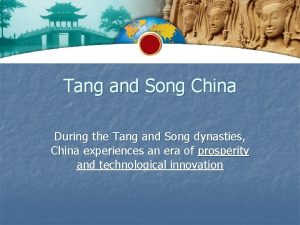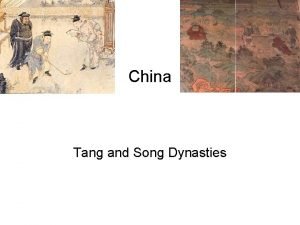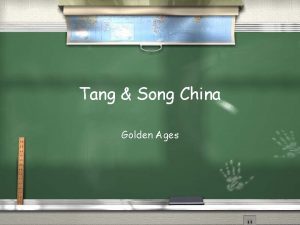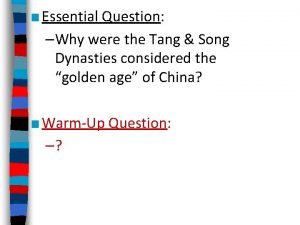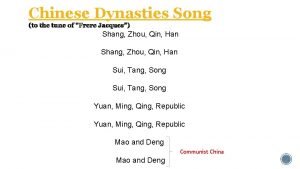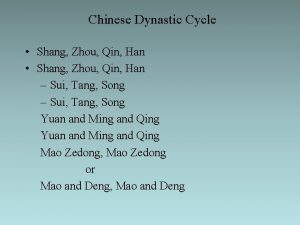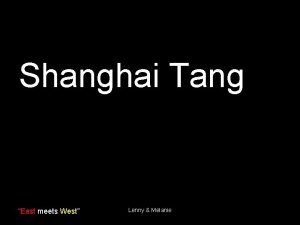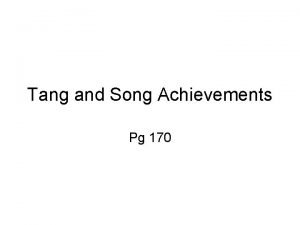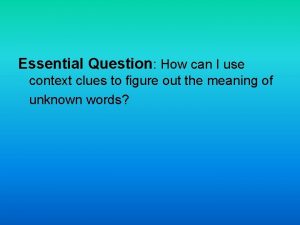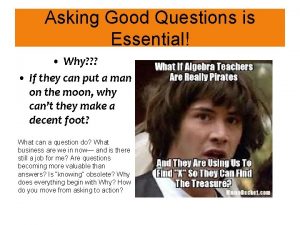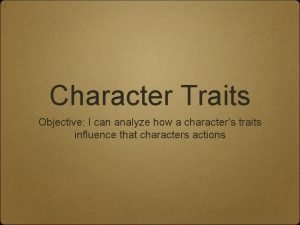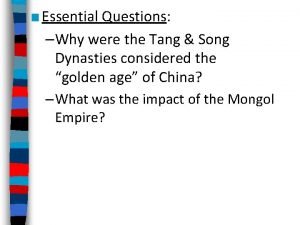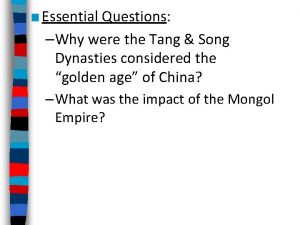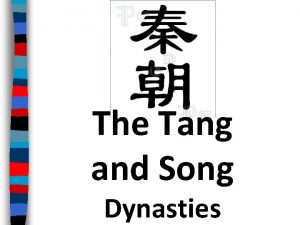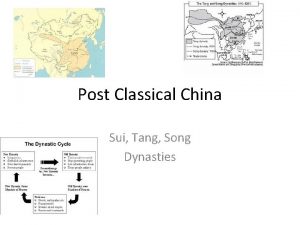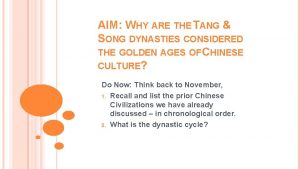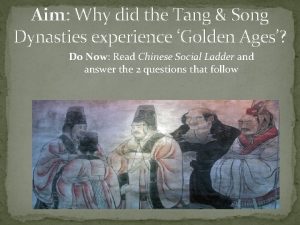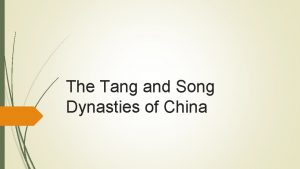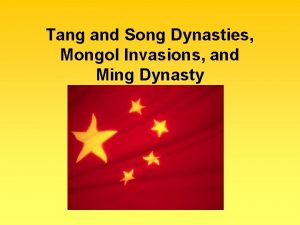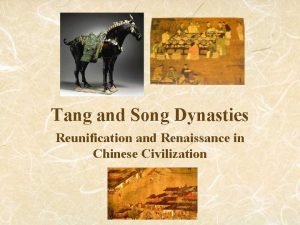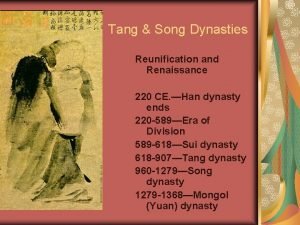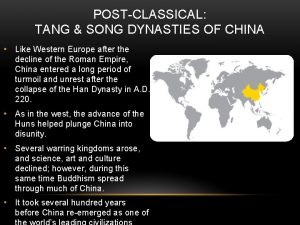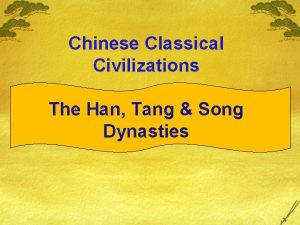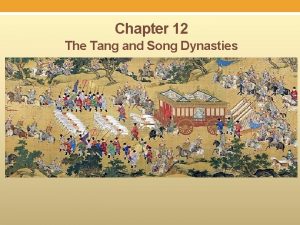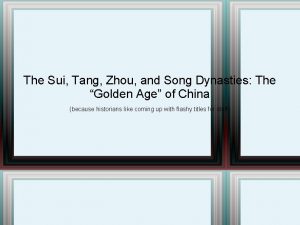Essential Question Why were the Tang Song Dynasties





































- Slides: 37

■ Essential Question: –Why were the Tang & Song Dynasties considered the “golden age” of China? ■ Warm-Up Question: –?

Classical China During the Classical Era, the emperors of Han China created large empire & developed numerous innovations The Silk Road trade route brought Civil service Silk-making exams technology for Chinese luxury goods to Europe & Asia gov’t employees that attracted based trade and increased on Confucian from outside teachings China cultural diffusion


Post-Classical China Like the Roman Empire, Classical China under the Han Dynasty entered an era of decline & eventually fell

After the Han Dynasty collapsed in 220 A. D. , no emperor was strong enough to unify China Over the next 350 years, more than 30 local dynasties rose & fell


In 589, China was unified …the restoration of the again & a strong central examination system government was restored. . . allowed intelligent During the Tang & Song Dynasties, China experienced bureaucrats to help an extended “golden age” &manage becamethe theempire richest, most powerful, & most advanced country in the world


Emperors did their best to Chinese merchants relied Golden of Post-Classical try. The to protect the. Age routes on ocean routes China as well to along the Silk Road trade with India & Arabia ■ Text Increased trade led to the spread of Chinese culture (centralized gov’t, Confucianism, & writing) to Korea, Japan, & Southeast Asia For the 1 st time in China’s history, emperors encouraged foreign trade

Increased trade helped spread Buddhism throughout China


Chinese Innovations ■ The Tang & Song dynasties were eras of major technological advancement: –The technologies helped make China the most advanced country in the world –Much of China’s technology spread to other people across trade routes Class Activity: Working with a partner, guess what each of the following 10 Chinese innovations are

1. Mechanical Clock

. Magnetic compass

. Gunpowder

4. Printing Press

5. Paper money

6. Chinese writing

7. Ship building

8. Vaccination

9. Silk weaving

10. Porcelain

Improvements in Agriculture ■ Fast-Ripening Rice ( got this from the Vietnamese after military expansion) Now they can produce rice twice a year!! ■ Increased Agricultural production ■ Population Growth (60 to 115 million)


Gender Roles ■ Roles of women – Confinement – homemakers, confined, limited rights – Women not educated ■ Roles of men – Could “roam” and other “relationships” were ok – Men allowed great freedom – Men favored in inheritance, divorce ■ Foot binding – common and showed patriarchy*


Foot binding The mincing steps. The swaying hips. The little nubbins at the ends of women's legs, carefully tucked into miniature, ornate shoes. For 1, 000 years, tiny, curved feet were considered the ultimate standard of feminine beauty in China, leading about 3 billion Chinese women to bind their feet during this time. https: //www. youtube. com/watch? v=1 Pnf 1 S 8 u h. Ng

Foot-Binding in Song China ■ Broken toes by 3 years of age. v Size 5 ½ shoe on the right

Foot-Binding in Song China Mothers bound their daughters’ feet.


The End of the Golden Age ■ Despite the wealth & culture during under the Tang & Song Dynasties, the Chinese were briefly overthrown by the Mongols –From 1279 to 1368, foreign nomads called the Mongols ruled China

In 1368, the Chinese overthrew the Mongols & established the Ming Dynasty The Ming emperors encourage overseas trade…


…and began a series of explorations led by Zheng He to demonstrate Chinese superiority

Read excerpt and than the Zhengthe He had better from ships &Zheng traveled. He farther With fleet of over 100 ships, any a. European explorers would for 100 years Treasure Fleet Expeditions Zheng He led 7 different expeditions Zheng He explored areas along the Indian Ocean & Africa, expand trade, & collected tribute from foreigners

Chinese Isolation ■ After the 7 th treasure fleet voyage in 1433, Chinese leaders unexpectedly ended the expeditions & retreated into isolationism –Scholar-officials complained that Zheng He’s voyages used valuable resources that were needed to defend China –China’s official trade policy was to keep the influence of outsiders to a minimum –China’s geography & gov’t policies kept it relatively isolated for the next 300 years until European merchants in the 1800 s demanded access to Chinese trade

 Why were the tang and song dynasties golden ages
Why were the tang and song dynasties golden ages Tang song menu
Tang song menu Sui tang and song dynasties
Sui tang and song dynasties Tang vs song dynasty venn diagram
Tang vs song dynasty venn diagram Sui tang and song dynasties
Sui tang and song dynasties Sui tang song dynasties
Sui tang song dynasties Golden age of tang and song dynasties
Golden age of tang and song dynasties Sui tang and song dynasties
Sui tang and song dynasties 618 song
618 song How did the sui and tang dynasties reunite china
How did the sui and tang dynasties reunite china The tang and song eras were a golden age of
The tang and song eras were a golden age of Xia shang zhou qin han
Xia shang zhou qin han Why why why why
Why why why why Sự nuôi và dạy con của hổ
Sự nuôi và dạy con của hổ Khi nào hổ mẹ dạy hổ con săn mồi
Khi nào hổ mẹ dạy hổ con săn mồi Costa levels of questioning
Costa levels of questioning Dar al islam spice chart
Dar al islam spice chart Chinese dynastic cycle
Chinese dynastic cycle Tang and song china chapter 12 section 1
Tang and song china chapter 12 section 1 Melanie tang
Melanie tang Sui tang song
Sui tang song Song dynasty accomplishments
Song dynasty accomplishments Sui tang song
Sui tang song Essential non essential fatty acids
Essential non essential fatty acids Dont ask why why why
Dont ask why why why Language
Language Tina ordered a replacement part for her desk
Tina ordered a replacement part for her desk Essential question generator
Essential question generator Pythagorean theorem essential questions
Pythagorean theorem essential questions Language
Language Individual vs. society
Individual vs. society Use context clues in figuring out the meaning
Use context clues in figuring out the meaning What is the essential question in cornell notes
What is the essential question in cornell notes Open-ended questions examples
Open-ended questions examples Essential questions for multiplication
Essential questions for multiplication Essential question gif
Essential question gif Objective traits
Objective traits Cornell way
Cornell way

